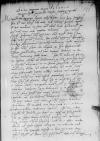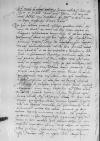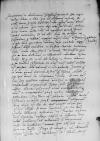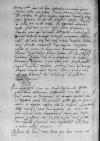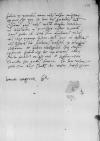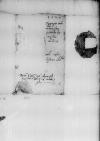Licet heri scripserimus iam Strenuitati Tuae pares litteras
nostras, sed volentes hoc ipsum negotium Strenuitati Tuae inculcare, ut sciat, quanti illud cordi habeamus, per has nostras iterum omnia repetere voluimus.
Hoc mense Augusti habuimus ⌊⌋ Strenuitatis Tuae sub
dat(a) or dat(o)⌈dat(a)dat(a) or dat(o)⌉
⌊Toleti⌋ I Iunii, quae nobis gratissimae fuerunt, cum quibus accepimus exemplar privilegii confirmationis capitulorum matrimonii nostri conficiendae. In quo nobis placet illa clausula, quod ipsa confirmatio caesarea perinde valeat ac si tunc tempore contracti et consummati matrimonii facta foret. Hoc tamen nobis non placet, quod ⌊caesarea maiestas⌋ non declaravit in eodem privilegio omnes et singulas obligationes in et contra huiusmodi capitula matrimonii directe vel indirecte, publice vel occulte factas etiam testamentaliter legatas nullius <esse> roboris vel momenti et nec nobis, nec bonis nostris praeiudicare aut nocere posse. Nam cuius est condere, illius est et interpretari. Si ergo s(acra) ⌊caesarea maiestas⌋ interponit auctoritatem suam in confirmationem capitulorum, interponat et in declarationem, et in interpretationem eorundem. Nam propter hoc magis fecimus confirmare illa capitula, ut excludamus adversarios illos testamentarios ab eorum actione, quam nobis pro illis legatis intentare contendunt, et ut Strenuitas Tua rem omnem oculis subiciat, revideat quintum matrimonii capitulum. Item dicit eadem illustrissima domina ⌊Isabella⌋, quae supra etc. usque ad illam particulam. Ita quod ipsorum bonorum stabilium quocumque nomine appellatorum neque partem aliquam, cuiuscumque modi sit, possit vendere, donare, ad pias causas relinquere nec ullo alio modo alienare sine expresso consensu et bona voluntate tam ipsius illustrissimae dominae ⌊Bonae⌋, quam ipsius ⌊serenissimi regis⌋ eius coniugis.  BCz, 1601, p. 578 Sed tantum de annuis praedictorum bonorum reditibus liceat ipsi illustrissimae dominae ⌊Isabellae⌋ facere, quod libuerit, sed integram omnium stabilium rerum successionem ipsi illustrissimae dominae ⌊Bonae⌋ et eius ut supra successoribus servare teneatur.
BCz, 1601, p. 578 Sed tantum de annuis praedictorum bonorum reditibus liceat ipsi illustrissimae dominae ⌊Isabellae⌋ facere, quod libuerit, sed integram omnium stabilium rerum successionem ipsi illustrissimae dominae ⌊Bonae⌋ et eius ut supra successoribus servare teneatur.
Ex hac ultima particula resultat quoddam dubium. Nos enim ita dicimus, quod ⌊mater nostra⌋, dum vixit, exsistens iam dumtaxat usufructuaria bonorum nostrorum, non poterat aliquas obligationes facere in istis bonis nostris super aliquibus summis pecuniarum perpetuis. Nam ita imposuisset, prout imposuit, tantas pecuniarum summas ad illa bona, quae etiam valorem eorum extenderent et ita nos exhereditare potuisset in collusionem et circumventionem capitulorum matrimonii nostri. Sed nos pro certo scimus et sunt adhuc vivi testes intentionis et propositi ⌊matris nostri(!)⌋, quod ipsa intellexit tales obligationes super annuis praedictorum bonorum proventibus facere potuisse vita sua durante, quae tamen durare non poterant nec debuerant vita eius cessante, nec ipsa requisisset a nobis consensum in vita sua ad
faciend(um) or faciend(as)⌈faciend(um)faciend(um) or faciend(as)⌉
aliquas obligationes, si potuisset propria auctoritate facere eiusmodi obligationes. Quem tamen consensum nos praestare noluimus. Et ita illi improbi legatarii ea iam languente extorserunt ab eadem illas obligationes summam in bonis nostris summam quingentorum milium ducatorum excedentem, quas a nobis iure repetere contendunt suis cavillationibus et depactationibus virtute dictae ultimae particulae in dicto ultimo capitulo matrimonii contentae. Et propterea hortamur et cum magno studio requirimus Strenuitatem Tuam, faciat in hoc maiorem, quam poterit, diligentiam et omnem suam impendat operam, ut si adhuc non miserit illud privilegium confirmationis capitulorum matrimonii nostri, procuret addi et apponi illam clausulam  BCz, 1601, p. 579 interpretationis et declarationis huiusmodi particulae. Ita videlicet intelligi debuit et debet quoad obligationes eiusmodi de annuis bonorum huiusmodi reditibus vita ipsius matris durante et non cessante, hoc enim videlicet vita dua durante potuit facere ⌊mater nostra⌋ nobis non requisitis secundum formam capituli matrimonii et non alias. Nam ita potuisset nos exhereditare per indirectum impositis magnis summis obligationum perpetuarum annuatim on the margin⌈perpetuarum annuatimperpetuarum annuatim on the margin⌉ ad ipsa bona, quae etiam valorem eorum excederent. Et nos fuissemus dolose circumventae et frustratae capitulis matrimonii nostri contra illorum formam et tenorem. Et propterea hoc eget in bona declaratione et interpretatione vel con ⌊caesareae maiestatis⌋. Et quod ita et non alias iudicari et decerni debeat per su concilium collaterale et alios omnes iudices sublata eis potestate aliter iudicandi et interpretandi, irritum quoque et inane exnunc decernere, si secus quam ⌊caesarea maiestas⌋ super his decretum sive interpretatum fuerit, si vero Strenuitas Tua iam expedivit eiusmodi privilegium et misit, extunc recapitulando et exponendo caesareae maiestati hoc gravamen nostrum obtineat ad partem aliud privilegium declarationis et interpretationis huiusmodi capituli secundum formam prout supra. Nam licet nos habeamus suspectum consilium collaterale in causis huiusmodi interpretationis obligationum, nam aliqui ex illis seu eorum amicis ad hoc suum habent interesse, si tamen impetemur ab illis coram concilio collaterali, defendemus nos privilegio confirmationis capitulorum nostrorum, quod si non suffecerit, tunc habeb producemus eis declarationem et interpretationem eiusdem et cogitabimus revocare huc Strenuitatem Tuam et honorare singulariter. Alioquin si adversarii nostri obtinuerint aliquid contra nos, appellabimus ad ⌊caesaream maiestatem⌋
BCz, 1601, p. 579 interpretationis et declarationis huiusmodi particulae. Ita videlicet intelligi debuit et debet quoad obligationes eiusmodi de annuis bonorum huiusmodi reditibus vita ipsius matris durante et non cessante, hoc enim videlicet vita dua durante potuit facere ⌊mater nostra⌋ nobis non requisitis secundum formam capituli matrimonii et non alias. Nam ita potuisset nos exhereditare per indirectum impositis magnis summis obligationum perpetuarum annuatim on the margin⌈perpetuarum annuatimperpetuarum annuatim on the margin⌉ ad ipsa bona, quae etiam valorem eorum excederent. Et nos fuissemus dolose circumventae et frustratae capitulis matrimonii nostri contra illorum formam et tenorem. Et propterea hoc eget in bona declaratione et interpretatione vel con ⌊caesareae maiestatis⌋. Et quod ita et non alias iudicari et decerni debeat per su concilium collaterale et alios omnes iudices sublata eis potestate aliter iudicandi et interpretandi, irritum quoque et inane exnunc decernere, si secus quam ⌊caesarea maiestas⌋ super his decretum sive interpretatum fuerit, si vero Strenuitas Tua iam expedivit eiusmodi privilegium et misit, extunc recapitulando et exponendo caesareae maiestati hoc gravamen nostrum obtineat ad partem aliud privilegium declarationis et interpretationis huiusmodi capituli secundum formam prout supra. Nam licet nos habeamus suspectum consilium collaterale in causis huiusmodi interpretationis obligationum, nam aliqui ex illis seu eorum amicis ad hoc suum habent interesse, si tamen impetemur ab illis coram concilio collaterali, defendemus nos privilegio confirmationis capitulorum nostrorum, quod si non suffecerit, tunc habeb producemus eis declarationem et interpretationem eiusdem et cogitabimus revocare huc Strenuitatem Tuam et honorare singulariter. Alioquin si adversarii nostri obtinuerint aliquid contra nos, appellabimus ad ⌊caesaream maiestatem⌋  BCz, 1601, p. 580 et Tua Strenuitas sciet ibi bene defendere et terminare hanc causam nostram pro iustitia. Interea volumus, ut adhuc ⌊ibi⌋ immoretur et hanc causam expediat ms. expectat(!)
⌈expediatexpediat ms. expectat(!)
⌉ sequaturque ubique curiam caesaream et hoc ibi diligenter observet. Nam si in praesentia sua multa temptant et reportant adversarii nostri, quid tunc in eius absentia facere potuissent? Et maxime quia agitur de summa L-ta milium et ultra, quam a nobis vellent iniuriose et iniuste extorquere adversarii nostri. Nos autem Strenuitatem Tuam iam a tribus mensibus mandavimus providere competenter, videlicet singulis mensibus quam diu ibi steterit et donec eam revocaverimus octingentis(!) florenis, quod dudum debuit scribere Strenuitati Tuae magnificus ⌊Ludovicus Aliphius⌋ noster orator et secretarius, et certum mercatorem designare, a quo Strenuitas Tua huiusmodi pecunias singulis mensibus repeteret. Nolumus enim, quod deinceps aliquid recipiat apud dominos ⌊Focaros⌋, quibus etiam nos iam solvimus illos et trecentos et cedulam vestram repetiimus.
BCz, 1601, p. 580 et Tua Strenuitas sciet ibi bene defendere et terminare hanc causam nostram pro iustitia. Interea volumus, ut adhuc ⌊ibi⌋ immoretur et hanc causam expediat ms. expectat(!)
⌈expediatexpediat ms. expectat(!)
⌉ sequaturque ubique curiam caesaream et hoc ibi diligenter observet. Nam si in praesentia sua multa temptant et reportant adversarii nostri, quid tunc in eius absentia facere potuissent? Et maxime quia agitur de summa L-ta milium et ultra, quam a nobis vellent iniuriose et iniuste extorquere adversarii nostri. Nos autem Strenuitatem Tuam iam a tribus mensibus mandavimus providere competenter, videlicet singulis mensibus quam diu ibi steterit et donec eam revocaverimus octingentis(!) florenis, quod dudum debuit scribere Strenuitati Tuae magnificus ⌊Ludovicus Aliphius⌋ noster orator et secretarius, et certum mercatorem designare, a quo Strenuitas Tua huiusmodi pecunias singulis mensibus repeteret. Nolumus enim, quod deinceps aliquid recipiat apud dominos ⌊Focaros⌋, quibus etiam nos iam solvimus illos et trecentos et cedulam vestram repetiimus.
Bene fecit Strenuitas Tua, quod magnifico ⌊Sigismundo Gofredo(!)⌋ gratiam nostram declaravit. Experietur eam sibi et suis utilem et benignam ac semper pro suo voto et desiderio pronam et paratam, quando ipse ita prout coepit se negotiis nostris fide et integerrime accommodabit nobis nostrisque rebus bene consultum esse voluerit. Ea etiam intentione ductae acceptavimus libenter suum consanguineum pro officiali nostro et sibi ac suis erimus pro voto nec aliquod gravamen aut impedimentum rerum suarum a nobis umquam sentiet.
Postremo de bonis ⌊Monte Serico⌋, quae bona ⌊mater nostra⌋  BCz, 1601, p. 581 habuit in recambium: dant nobis adhuc molestiam, etiam parte fisci regii, et licet nos habuerimus litteras caesareas, quas nobis venerabilis ⌊Borgk⌋ attulit, ut conservemur in privilegiis nostris, quarum copias habet ibi Strenuitas Tua registratas. Volumus, ut iterum exponat ⌊caesareae maiestat⌋i, quia non obstantibus illis caesareis litteris habemus molestiam, quod severiores scribantur et habeat intelligentiam cum magnifico ⌊Sigismundo Gofredo(!)⌋ super hoc, quod severius etiam concilio scribatur et ipse etiam dominus Sigismundus commendet hoc, quibus sciverit.
BCz, 1601, p. 581 habuit in recambium: dant nobis adhuc molestiam, etiam parte fisci regii, et licet nos habuerimus litteras caesareas, quas nobis venerabilis ⌊Borgk⌋ attulit, ut conservemur in privilegiis nostris, quarum copias habet ibi Strenuitas Tua registratas. Volumus, ut iterum exponat ⌊caesareae maiestat⌋i, quia non obstantibus illis caesareis litteris habemus molestiam, quod severiores scribantur et habeat intelligentiam cum magnifico ⌊Sigismundo Gofredo(!)⌋ super hoc, quod severius etiam concilio scribatur et ipse etiam dominus Sigismundus commendet hoc, quibus sciverit.
Et bene valeat Strenuitas Tua.
 BCz, 1601, p. 578 Sed tantum de annuis praedictorum bonorum reditibus liceat ipsi illustrissimae dominae
BCz, 1601, p. 578 Sed tantum de annuis praedictorum bonorum reditibus liceat ipsi illustrissimae dominae  BCz, 1601, p. 579 interpretationis et declarationis huiusmodi particulae. Ita videlicet intelligi debuit et debet quoad obligationes eiusmodi de annuis bonorum huiusmodi reditibus vita ipsius matris durante et non cessante, hoc enim videlicet vita dua durante potuit facere
BCz, 1601, p. 579 interpretationis et declarationis huiusmodi particulae. Ita videlicet intelligi debuit et debet quoad obligationes eiusmodi de annuis bonorum huiusmodi reditibus vita ipsius matris durante et non cessante, hoc enim videlicet vita dua durante potuit facere  BCz, 1601, p. 580 et Tua Strenuitas sciet ibi bene defendere et terminare hanc causam nostram pro iustitia. Interea volumus, ut adhuc
BCz, 1601, p. 580 et Tua Strenuitas sciet ibi bene defendere et terminare hanc causam nostram pro iustitia. Interea volumus, ut adhuc  BCz, 1601, p. 581 habuit in recambium: dant nobis adhuc molestiam, etiam parte fisci regii, et licet nos habuerimus litteras caesareas, quas nobis venerabilis
BCz, 1601, p. 581 habuit in recambium: dant nobis adhuc molestiam, etiam parte fisci regii, et licet nos habuerimus litteras caesareas, quas nobis venerabilis 